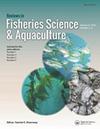Fifty Years of Sustained Production from the Australian Abalone Fisheries
引用次数: 43
Abstract
The sustained production of abalone from the five state-managed (Tasmania, Victoria, South Australia, New South Wales, and Western Australia) Australian abalone fisheries has contrasted with many of those elsewhere that exhibited rapid and sustained declines in production. Australian abalone fisheries are significant at local, regional, state, national, and international scales. Key attributes are (1) harvesting, processing, and reinvestment of profits occur away from major metropolitan centers; (2) they are among the most valuable wild-catch species in all states; (3) the combined Australian abalone harvest in 2011 (>4,500 t) had a landed value of ∼AU$200M and represented 15% of the Australian total wild-catch production; and (4) this level of production made these fisheries the dominant contributor (60%) to global wild-catch abalone production. Unlike many other abalone fisheries, total catches were controlled by limited entry, quotas, size limits, and geographic boundaries, overseen by stringent compliance regimes, early in their history. Subsequently, state-based research programs, explicitly tasked with providing scientific advice to support management decisions, undertook assessments to match harvests with stock productivity. This information upon which to base management decisions contributed to long-term (>20 years) stable harvests and enabled relationships among stakeholders to develop around consideration of the information and advice for management. In general, rights-holders developed stewardship for the resource, and this has led to numerous important outcomes, including evolving resource co-management and a nationally representative industry entity, the Abalone Council of Australia. The Abalone Council of Australia, state-based industry entities, and ongoing relationships among rights-holders, fishery managers, and researchers play vital roles in addressing and overcoming current and impending challenges for these fisheries. These difficulties include (1) urban encroachment into coastal regions (the so-called “sea change” phenomenon); (2) a growing interest in access to the abalone resource, reflecting the increasing, culturally diverse Australian population; (3) the ever-present threat of illegal fishing; (4) recent total allowable commercial catch reductions, particularly in Victoria and New South Wales, to facilitate stock rebuilding; (5) changing market conditions; (6) declining profitability from increasing operational costs and appreciation of the Australian dollar; and (7) environmental changes, such as prolonged drought and warmer seas associated with shifts in climate. Overall, this review demonstrates that abalone can be harvested sustainably over extended periods, despite aspects of their demography that suggest higher vulnerability to overexploitation, providing the management systems that control harvesting activities and external impacts that encompass several key underpinning elements. This review also identifies likely challenges to sustained production and shows that the future of these stocks and fisheries will require proactive strategies to mitigate current threats to sustainability and to maintain economically viable productivity.澳大利亚鲍鱼渔业50年的持续生产
五个国家管理的(塔斯马尼亚州、维多利亚州、南澳大利亚州、新南威尔士州和西澳大利亚州)澳大利亚鲍鱼渔场的持续生产与其他许多地方的鲍鱼渔场形成鲜明对比,这些渔场的产量呈现出快速和持续的下降。澳大利亚鲍鱼渔业在地方、区域、州、国家和国际范围内都很重要。关键属性是:(1)利润的收获、加工和再投资发生在远离主要大都市中心的地方;(2)它们是所有州最有价值的野生捕捞物种;(3) 2011年澳大利亚鲍鱼总产量(约4500吨),上岸价值约2亿澳元,占澳大利亚野生捕捞总产量的15%;(4)这种生产水平使这些渔业成为全球野生鲍鱼产量的主要贡献者(60%)。与许多其他鲍鱼渔业不同,在其历史的早期,总捕获量受到限制入境、配额、大小限制和地理边界的控制,并受到严格的合规制度的监督。随后,以国家为基础的研究项目进行了评估,以使收成与牲畜生产率相匹配,这些项目的明确任务是提供科学建议以支持管理决策。作为管理决策基础的这些信息有助于实现长期(大约20年)的稳定收成,并使利益相关者之间的关系能够围绕对管理信息和建议的考虑而发展。总体而言,权利持有者发展了对资源的管理,这带来了许多重要成果,包括不断发展的资源共同管理和一个具有全国代表性的行业实体——澳大利亚鲍鱼理事会。澳大利亚鲍鱼理事会、以国家为基础的行业实体,以及权利持有人、渔业管理者和研究人员之间的持续关系,在解决和克服这些渔业当前和即将面临的挑战方面发挥着至关重要的作用。这些困难包括:(1)城市对沿海地区的侵占(所谓的“海洋变化”现象);(2)对获取鲍鱼资源的兴趣日益浓厚,这反映了澳大利亚人口的不断增长和文化多样性;(3)非法捕鱼的威胁始终存在;(4)最近的允许商业捕捞总量减少,特别是在维多利亚州和新南威尔士州,以促进种群重建;(五)市场情况的变化;(6)经营成本增加和澳元升值导致盈利能力下降;(7)环境变化,如与气候变化相关的长期干旱和海洋变暖。总体而言,本综述表明,尽管鲍鱼的人口结构方面表明其更容易受到过度开发,但可以长期可持续地捕捞,提供控制捕捞活动和包括几个关键基础要素的外部影响的管理系统。该审查还确定了可持续生产可能面临的挑战,并表明这些种群和渔业的未来将需要采取积极主动的战略,以减轻目前对可持续性的威胁,并保持经济上可行的生产力。
本文章由计算机程序翻译,如有差异,请以英文原文为准。
求助全文
约1分钟内获得全文
求助全文

 求助内容:
求助内容: 应助结果提醒方式:
应助结果提醒方式:


